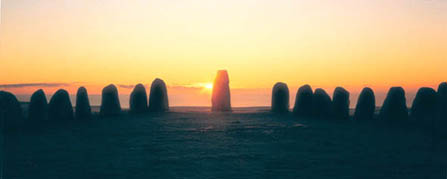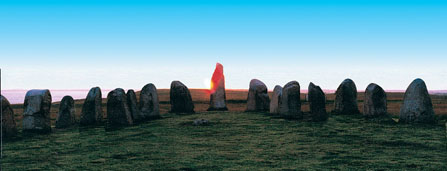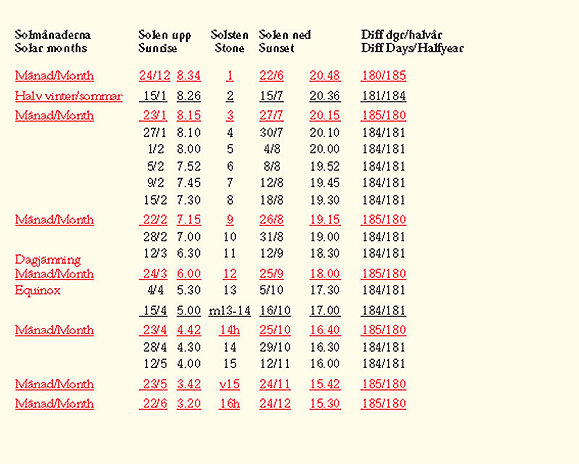|
The Sun year calendar
Identical
The viking’s comprehension of time also corresponds
with the placement of Ales stenar. The sun year calendar of the vikings
commenced at the winter solstice and consisted of 360 days divided
into 12 months of 30 days each. At the summer solstice the month
of the sun began. This month consisted of 35 days (i.e. 5 days were
added).

Sunrise at the winter solstice
© Foto Bob G Lind
| |
These empirical sunstudies have
been performed sitting on a chair at the observation site. |
Sunrises
Winter solstice, the shortest day of the year: Seen from the observation
site the sun rises at the winter solstice by and over the southeast stemstone.
During six months of 30 days each the sunrises are read between the stones
1a-3a-9a-12a-14a-15a and to the center stone 16a, which marks the summer
solstice, (see photo and schedule).
| NV |
 |
SO |
Click
here for the calendarical sunrises and sunsets over the month-stones

Sunset at the summer solstice.
Sunsets
Summer solstice, the longest day of the year:
The sun sets over the northwestern stemstone. The following month counts
35 days (the month of the sun in Nordic mythology). After this the sunsets
are read to the time of the winter solstice after exactly the same 30-day
system as by the sunrises, here marked 1b-3b-9b-12b-14b-15b-16b. To
the first month after the summer solstice, 5 days were added, and every
fourth year a leap-day was inserted (in the same way as in the Viking
Calendar). This is clearly illustrated by the distance between the second
and third stone, which is wider than the distance between the stones
on the opposite side. The difference between the sunrises and sunsets
is always 6 months and 12 hours in the calendar. For comparison:
5.000 years ago the Egyptians had developed a sun calendar of 365 days
in a year divided into eleven months of 30 days plus one month of 35
days.
OBS!
Printable photodocumentation
The solar orbit
For 2.500 years, the solar orbit's change at the horizon, seen from
the observation site in relation to the calenderstones, is negligable.

|



